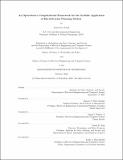An Open-Source Computational Framework for the Scalable Application of Electrification Planning Models
Author(s)
Aoudi, Lama Sara
DownloadThesis PDF (70.10Mb)
Advisor
Pérez-Arriaga, Ignacio J.
Kirtley Jr., James L.
Terms of use
Metadata
Show full item recordAbstract
Global efforts to achieve affordable, universal electrification are inextricably linked to the uptake and application of spatially explicit computational electrification planning tools. The tools automate the delineation of potential modes of electrification (grid extension, mini-grids, and stand-alone solar systems) across all customers, at the lowest cost. My thesis aims to expedite universal electrification by designing a scalable and modular framework on how to leverage open-source information, to produce granular estimates of the data needed by these planning tools. The design of the framework is configured to the input requirements of the most data-demanding tool in the field, the Reference Electrification Model (REM). The REM inputs modelled in my framework are the following: 1) the geolocation and demand characteristics of residential customers, 2) the geolocation and demand characteristics of social and productive customers, 3) the electrification status of each customer, and 4) the layout of the medium-voltage distribution network.
The framework prescribes a method, or Python model, to process and analyze existing open data into reasonable estimates of each REM input. The source code of the Python-based framework is available through GitHub, with directional documents on how to run each module to any region. Built-area population datasets are used to estimate the exact geolocation of all residential and smaller load customers (e.g., village community centers). The geolocation of non-residential loads, or community and productive customers (e.g., markets or large industrial plants), are extracted from the Google Maps API. To do so, the model iterates through an area-of-interest and searches the API for the locations and operational status of each customer type. Non-residential loads are ascribed demand patterns from t supporting literature on archetypal behaviors of larger loads. The Falchetta et al. (2019) is used to classify each customer’s electrification status and assign them a “tier” or level of electricity consumption. Finally, I propose leveraging the grid-design capabilities of REM to estimate a region’s existing medium voltage distribution network when it is unavailable through other means. To apply REM for the task, I initialize its model parameters to force an ‘all-grid-extension’ output and supply it with available a-priori information on the existing medium voltage network. Overall, my thesis lays the foundation for a complete transition of the energy access sector to granular, open-source modelling.
Date issued
2022-02Department
Massachusetts Institute of Technology. Department of Electrical Engineering and Computer Science; Massachusetts Institute of Technology. Institute for Data, Systems, and SocietyPublisher
Massachusetts Institute of Technology